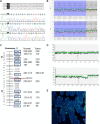BRCA1 p.His1673del is a pathogenic mutation associated with a predominant ovarian cancer phenotype
- PMID: 28186987
- PMCID: PMC5410251
- DOI: 10.18632/oncotarget.15151
BRCA1 p.His1673del is a pathogenic mutation associated with a predominant ovarian cancer phenotype
Abstract
We have investigated the clinical significance of the BRCA1 variant p.His1673del in 14 families from the Emilia-Romagna region of Italy, including 20 breast and 23 ovarian cancer cases; four families displayed site-specific ovarian cancer.The variant, absent in human variation databases, has been reported three times in BRCA1 specific databases; all probands shared the same rare haplotype at the BRCA1 locus, consistent with a common ancestor.The multifactorial likelihood method by Goldgar, used to estimate the probability of the variant being causative, gave a ratio of 2,263,474:1 in favor of causality. Moreover, in silico modeling suggested that His1673-lacking BRCA1 protein may have a decreased ability to bind BARD1 and other related proteins. All six ovarian carcinomas and two out of four breast carcinomas available showed a loss of the BRCA1 wild-type allele, which in three out of four ovarian carcinomas analyzed by FISH was associated with duplication of the chromosome 17 containing the variant. Although the pathogenicity of the allele is strongly supported by the multifactorial ratio,we cannot exclude that p.His1673del is not itself deleterious, but is linked to another undetected mutation on the same ancestral allele.
Keywords: BRCA1; VUS; breast cancer; hereditary cancer; ovarian cancer.
Conflict of interest statement
The authors declare they have no conflicts of interest.
Figures



Similar articles
-
Atypical cancer risk profile in carriers of Italian founder BRCA1 variant p.His1673del: Implications for classification and clinical management.Cancer Med. 2024 Aug;13(16):e70114. doi: 10.1002/cam4.70114. Cancer Med. 2024. PMID: 39194334 Free PMC article.
-
Germline BRCA1 mutations and loss of the wild-type allele in tumors from families with early onset breast and ovarian cancer.Clin Cancer Res. 1995 May;1(5):539-44. Clin Cancer Res. 1995. PMID: 9816013
-
Genetic analysis of a breast-ovarian cancer family, with 7 cases of colorectal cancer linked to BRCA1, fails to support a role for BRCA1 in colorectal tumorigenesis.Int J Cancer. 2000 Dec 1;88(5):778-82. doi: 10.1002/1097-0215(20001201)88:5<778::aid-ijc15>3.0.co;2-n. Int J Cancer. 2000. PMID: 11072248
-
Prevention and Screening in Hereditary Breast and Ovarian Cancer.Oncology (Williston Park). 2016 Oct 15;30(10):896-904. Oncology (Williston Park). 2016. PMID: 27753056 Review.
-
BRCA1: the enigma of tissue-specific tumor development.Trends Genet. 2003 Jun;19(6):312-5. doi: 10.1016/S0168-9525(03)00110-0. Trends Genet. 2003. PMID: 12801723 Review.
Cited by
-
Clinical genetic services in the Emilia-Romagna region, Italy: current activity and open issues: a mixed-method study.J Community Genet. 2025 Apr;16(2):139-150. doi: 10.1007/s12687-024-00750-7. Epub 2025 Jan 11. J Community Genet. 2025. PMID: 39797934 Free PMC article.
-
Molecular analysis of BRCA1 and BRCA2 genes in La Rioja (Spain): five new variants.Hered Cancer Clin Pract. 2024 Oct 22;22(1):22. doi: 10.1186/s13053-024-00296-2. Hered Cancer Clin Pract. 2024. PMID: 39438962 Free PMC article.
-
Reinterpretation of BRCA1 and BRCA2 variants of uncertain significance in patients with hereditary breast/ovarian cancer using the ACMG/AMP 2015 guidelines.Breast Cancer. 2019 Jul;26(4):510-519. doi: 10.1007/s12282-019-00951-w. Epub 2019 Feb 6. Breast Cancer. 2019. PMID: 30725392
-
Reclassification of BRCA1 and BRCA2 variants found in ovarian epithelial, fallopian tube, and primary peritoneal cancers.J Gynecol Oncol. 2020 Nov;31(6):e83. doi: 10.3802/jgo.2020.31.e83. J Gynecol Oncol. 2020. PMID: 33078592 Free PMC article.
-
Analysis of BRCA1/2 variants of unknown significance in the prospective Korean Hereditary Breast Cancer study.Sci Rep. 2021 Apr 19;11(1):8485. doi: 10.1038/s41598-021-87792-w. Sci Rep. 2021. PMID: 33875706 Free PMC article.
References
-
- Spurdle AB, Healey S, Devereau A, Hogervorst FBL, Monteiro ANA, Nathanson KL, Radice P, Stoppa-Lyonnet D, Tavtigian S, Wappenschmidt B, Couch FJ, Goldgar DE, on behalf of ENIGMA ENIGMA-Evidence-Based Network for the Interpretation of Germline Mutant Alleles: an international initiative to evaluate risk and clinical significance associated with sequence variation in BRCA1 and BRCA2 genes. Hum Mutat. 2012;33:2–7. - PMC - PubMed
-
- Judkins T, Hendrickson BC, Deffenbaugh AM, Eliason K, Leclair B, Norton MJ, Ward BE, Pruss D, Scholl T. Application of embryonic lethal or other obvious phenotypes to characterize the clinical significance of genetic variants found in trans with known deleterious mutations. Cancer Res. 2005;65:10096–10103. - PubMed
MeSH terms
Substances
LinkOut - more resources
Full Text Sources
Other Literature Sources
Medical
Miscellaneous

